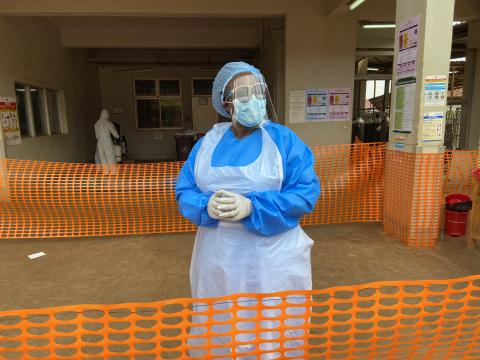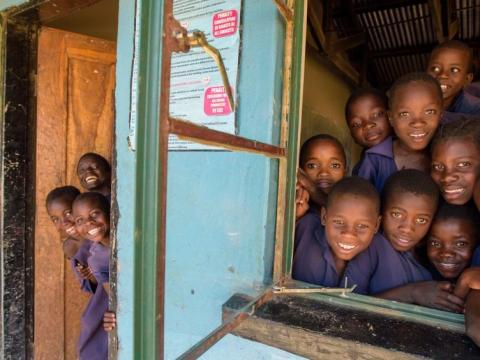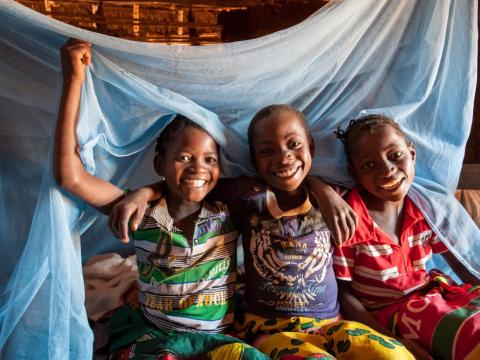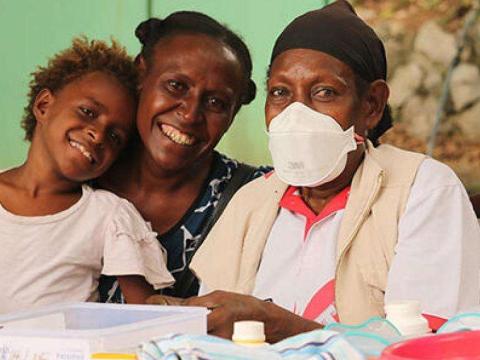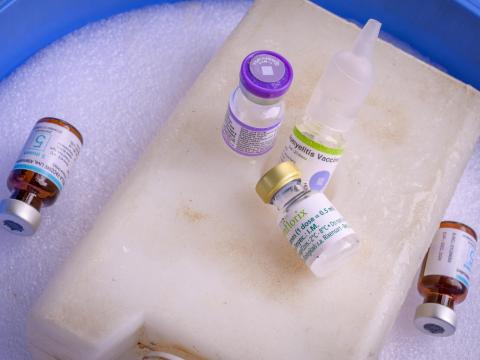Infectious Diseases
In low- and middle-income countries, children are significantly more vulnerable to infectious diseases and are 18 times more likely to die from them compared to children in high-income countries (UNICEF). Many of these diseases – including polio, measles, diphtheria, tetanus, and pertussis – are preventable through early vaccination. Others, such as malaria, tuberculosis, and HIV/AIDS, remain persistent challenges. Reducing their spread through community-based strategies and the provision of essential health commodities is a key focus of World Vision's health work.
Through its integrated approach across health facilities, communities, and households, World Vision aims to reduce illness and death caused by infectious diseases. Strengthening community health worker programmes and supporting immunisation efforts are central to this work. Collaboration with governments, Ministries of Health, faith and community leaders, and donors ensures that these efforts are far-reaching, sustainable, and impactful.
Disease Programming
World Vision contributes to global efforts to control and eliminate infectious diseases by partnering in large-scale, multi-country health initiatives that strengthen community resilience and save lives. With the support of the Global Fund and other partners, World Vision implements programmes that prevent, detect, and treat infectious disease – including HIV, malaria, and tuberculosis – to protect the most vulnerable and promote lasting health outcomes.
Other Key Infectious Diseases
Cholera
Cholera remains a major global public health concern. This acute intestinal infection, caused by the bacterium Vibrio cholerae, spreads through contaminated water or food and can lead to severe watery diarrhoea, vomiting, and leg cramps. Without prompt treatment, it can cause rapid dehydration and death within hours. Young children, particularly infants, are especially vulnerable. Cholera is most prevalent in areas with poor sanitation, unsafe water, and disrupted infrastructure, often following natural disasters or conflict. Each year, cholera affects millions of people and causes tens of thousands of deaths worldwide. Prevention depends on access to safe water, adequate sanitation, good hygiene practices, vaccination, and rapid treatment to save lives and prevent outbreaks.
In 2025, cholera epidemics have worsened humanitarian crises across several countries. In the Democratic Republic of the Congo (DRC), the outbreak has deepened an already fragile situation, while in South Sudan, cases have reached critical levels, affecting more than 40,000 children, including 20,000 under the age of five, and placing millions more at risk. With over 88,000 cases and 1,500 deaths already reported, the outbreak is spreading at an alarming rate. Cholera outbreaks in Sudan pose a growing threat to children as the disease continues to spread amid severe funding shortages.
Coronavirus
On 11 March 2020, the World Health Organization declared COVID-19 a global pandemic. Within hours, World Vision launched one of the largest emergency responses in its history, spanning more than 70 countries. The response prioritised children and families living in the most vulnerable and fragile contexts – including conflict-affected areas, urban slums, and refugee settings – where the risks to children were greatest.
World Vision’s global COVID-19 response exceeded its targets, reaching more than 72 million people, including 36 million children.
The response focused on four key objectives:
- Scaling up prevention measures to limit the spread of the virus
- Strengthening health systems and frontline health workers, including training and equipping community health workers
- Supporting children affected by COVID-19 through education, child protection, food security, and livelihoods interventions
- Collaborating and advocating to protect the most vulnerable children
World Vision continues to build on the lessons and partnerships formed during the pandemic to strengthen preparedness and response to future global health emergencies. Learn more about World Vision's COVID-19 emergency response.
Ebola virus
The 2014–2016 Ebola outbreak in West Africa was the largest and most complex since the virus was first identified in 1976 (WHO). Subsequent outbreaks have continued to pose serious public health challenges, including the second-largest outbreak in history, which occurred in the Democratic Republic of the Congo (DRC) between 2018 and 2021.
World Vision continues to support communities that have survived past Ebola crises, as well as those currently facing new outbreaks. During the epidemic in Sierra Leone, World Vision’s health emergency response team reached 1.6 million people with lifesaving assistance.
Through collaboration with its Channels of Hope initiative, World Vision worked alongside community health workers and faith leaders to raise awareness, reduce stigma, and promote healthy behaviours that helped prevent further fatalities. This faith-based, community-driven approach remains central to World Vision's ongoing efforts to bring hope and support to families and communities affected by Ebola. Read more here.
World Vision also played a key role in advancing Ebola vaccine readiness as part of the Ebola Vaccine Deployment, Acceptance, and Compliance (EBODAC) consortium. From 2014 to 2021, EBODAC operated in the DRC, Rwanda, Sierra Leone, and Uganda, promoting the acceptance and uptake of new Ebola vaccines. Using mobile messaging, clear communication, and trust-building initiatives, EBODAC tackled vaccine hesitancy and strengthened local health systems. Working with ministries of health and community health workers, the project built local capacity and developed tools to support future vaccine deployment efforts.
Mpox
Between 2022 and 2024, mpox (formerly known as monkeypox) has seen a sharp rise in cases worldwide, including in countries not previously considered endemic. The virus has now been reported in 116 countries, highlighting its growing potential for global transmission. Unlike previous outbreaks, the current situation is marked by sustained human-to-human transmission, primarily through close physical contact within households and communities.
On 14 August 2024, the World Health Organization declared mpox a public health emergency of international concern, citing its disproportionate impact on vulnerable populations – especially children, immunocompromised individuals, and people in humanitarian settings.
Children in low- and middle-income countries, particularly those in fragile and crisis-affected contexts, face heightened risks due to overcrowding, weak healthcare systems, malnutrition, and limited access to clean water and sanitation. These conditions increase both their exposure to infection and the likelihood of severe illness.
Learn more about World Vision's emergency mpox response and how we are working to protect the most vulnerable.
"Preventing further spread is not just solidarity, but an investment in global health security," says Dan Irvine, Global Director, Health and Nutrition. He highlights the EU’s critical role against mpox, from vaccines to building further resilience in African health systems. Read his op ed in the EU Observer.
Polio
Since 1999, World Vision has been a key partner in the CORE Group Partners Project (CGPP) – a multi-country, multi-partner initiative working toward the global eradication of polio. The CGPP provides financial and technical support to strengthen vaccine uptake, disease surveillance, and health system capacity. Alongside polio eradication, the project also contributes to efforts to control other vaccine-preventable diseases, such as measles.
World Vision has contributed to these efforts in Angola, Bangladesh, Ethiopia, India, Kenya, and South Sudan, helping to ensure that children in the most vulnerable communities are protected from preventable diseases.
CORE Polio is a testament to civil society's role in public health, and collective action. It's remarkable that the world does not celebrate achievements like the elimination of polio more widely - it's the kind of story that gives us hope for a better future.
- Dan Irvine, Global Director, Health and Nutrition, World Vision International

For more on World Vision’s work to end polio, read Akujo Mary's story – an inspiring account of resilience and hope in the face of disability.
Zika virus
First detected in Brazil in May 2015, the Zika virus – transmitted by the Aedes aegypti mosquito – quickly became a global health concern. One of the major risks associated with Zika is its link to microcephaly, a congenital condition in which babies born to infected mothers may experience incomplete brain development.

In response to the outbreak, World Vision worked in affected countries to deliver essential services and resources to prevent transmission and protect vulnerable groups. Efforts included distributing mosquito nets, insect repellents, and protection kits for pregnant women, as well as providing health services for those infected.
Within just six months, World Vision reached more than three million people across over 1,000 communities in the most severely affected areas. The response focused on:
- Promoting personal protection behaviours and vector control
- Engaging communities in sanitation and awareness campaigns
- Supporting pregnant women with targeted information and resources
To strengthen the broader public health response, World Vision also collaborated with ministries of health and global health partners to collect and share epidemiological data, improving disease prevention and control efforts.
Learn how community volunteers and smartphones helped reveal dangerous gaps by surveying over 3,000 people across six countries.
